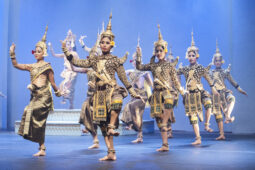The Royal Ballet of Cambodia, or “Apsara Dance”
The Royal ballet of Cambodia is a form of performing arts established in the royal courts of Cambodia for the purpose of entertainment as well as ceremonial propitiation. It is the dominant genre of dance theatre in Cambodia that features the classical dance style and is model of Thai dance theatre of the inner court. It […]

It is performed during public occasions and ceremonies in Cambodia as well as among Cambodians in other countries. Performances entails elaborately dressed dancers performing a slow and figurative set of gestures and poses meant to entrance the viewer. The repertoire includes dances of tribute or invocation and the enactment of traditional stories and epic poems such as the Ramayana. The music is played by an ensemble of xylophones, metallophones, woodwind instruments, drums, and gong chimes accompanied by a chorus.
According to Hindu mythology, Apsaras were beautiful female creatures that descended from heaven to entertain Gods and Kings by their dance. It is said that they, Apsaras, were Gandharvas’ wives who served at the palace of Indra, the King of Gods.
Originally, Apsara dance in Cambodia has sprung from Hinduism, until 13th century, this kind of dance changed a bit on the inspiration of sophisticated Angkor sculpture and Apsara carving in temples of ancient Khmer. Therefore, Apsara dance at present has strong feature of Khmer than the origin. Unfortunately, Apsara was nearly disappeared in 15th century due to the wiped-out Angkor civilization. Thanks to Queen Sisowath Kossamak, this traditional dance was recovered by the late 40s of the 20th century.
Though Apsara dance was traditionally performed only for the King, today it is performed for all Cambodians and tourists alike. Seen as the most important facet of traditional Cambodian classical dance, Apsara is still performed as a part of certain sacred ceremonies and award presentations. An enormous part of Cambodia’s national pride and heritage, Apsara dances often tell the stories depicted in the carvings of Angkor Wat. Traditionally, there are four primary roles in Apsara dance: the male, the female, the giant, and the monkey (usually played by a male dancer.) Though male dancers do play certain roles in Apsara dance, even today the art is practiced mostly by women. Apsara is also seen as a meeting point for different religions, as they stories invoked are seen in multiple religious texts and traditions. Though almost destroyed by the Khmer Rouge Regime, Apsara Dance continues today because of the surviving dancers, who committed themselves to its preservation by teaching the tradition to the next generation.
Apsara dance is known and recognized equally well around the world for its ornate costumes and headpieces. Many of the silk drapings (called sampot sarabap) and golden headpieces are modeled directly after the carvings of Angkor Wat. The lead dancer’s headpiece will have five points, while supporting dancers usually have only three. The principal dancer’s dress may also be in a different, brighter shade to set her apart. Sometimes, (though not as frequently in modern Apsara routines) a choker-like red or golden collar necklace, decorated with designs and copper adornments, are worn in addition to long earrings modeled after the krorsang flower. Perhaps the best-known accessories are the bracelets worn by Apsara dancers, of which there are four different kinds. Two kinds of anklets are also worn by the dancers, elegantly sliding and clinking together during performance. Finally, the sangvar, which can either be worn as a belt or carried on its own, is made of lightweight copper and decorated with golden and red floral designs.
If you are in Cambodia, Apsara dance is an experience not to be missed. A centerpiece of Cambodia’s culture and heritage, the tradition of Apsara dance is sure to continue for centuries to come.



